Abstract
A detailed analysis is presented of the ways in which control by the negative stimulus in two-comparison conditional discriminations may be expected to affect the outcome of tests for the properties of equivalence relations. Control by the negative stimulus should produce the following results: (a) no observable effect on symmetry tests; (b) reflexivity test results should look like “oddity” rather than “identity”; and (c) transitivity tests that involve an odd number of nodes should yield results that are 100% opposite to tests that involve an even number of nodes. The analysis also considers the effects of variation in the type of comparison-stimulus control between and within baseline conditional discriminations. Methods are suggested for experimentally regulating the type of control, and for verifying the predictions that the analysis generates. If suggested experiments continue to support the analysis, investigators who use two-comparison conditional discriminations to study equivalence relations will either have to control explicitly whether the positive or the negative comparison governs their subjects' choices, or they will have to abandon two comparisons and use three or more comparisons instead.
Keywords: stimulus control, equivalence relations, matching to sample, conditional discrimination, theoretical analysis
Full text
PDF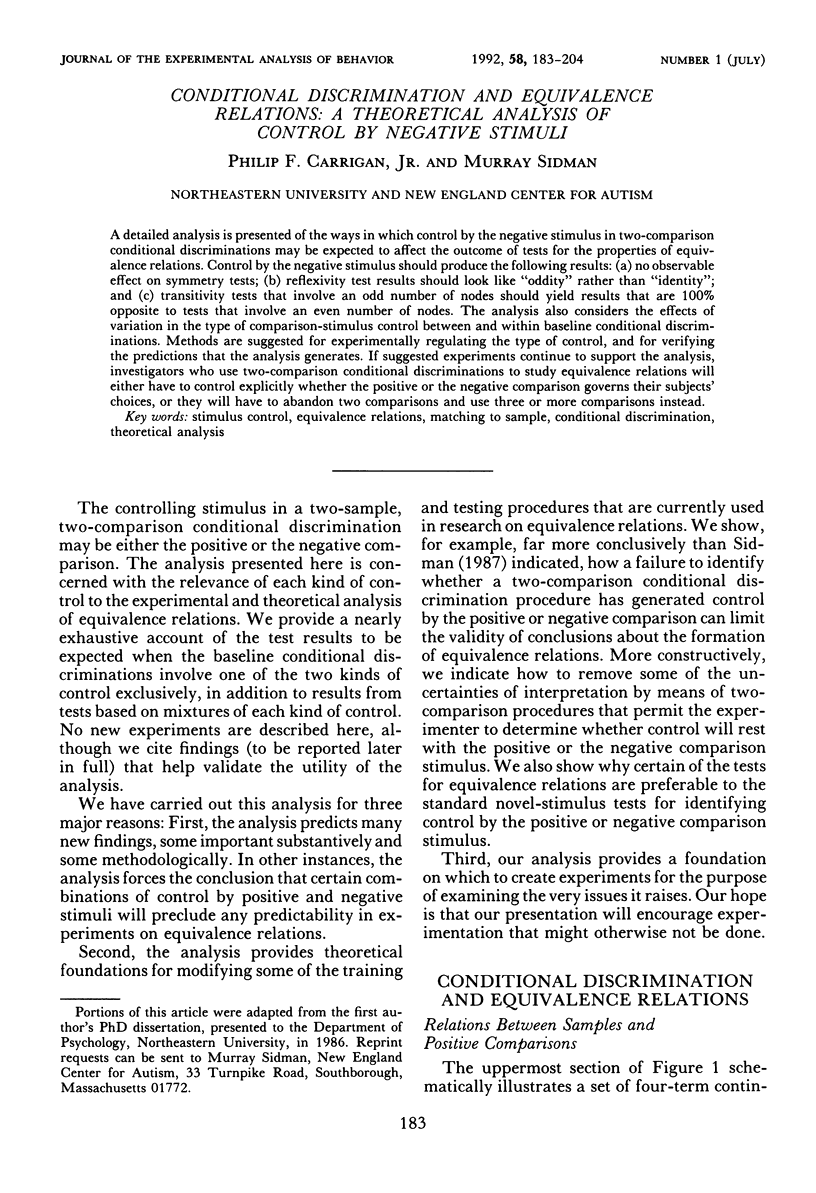

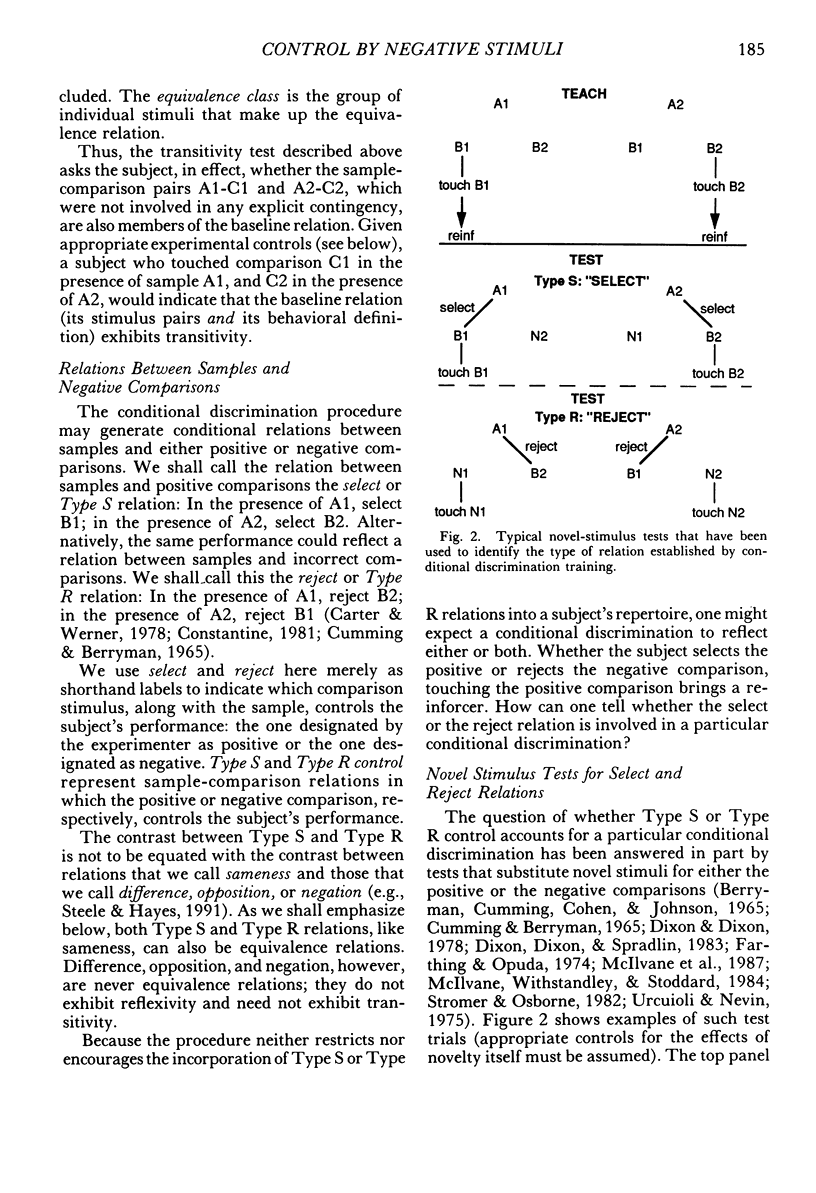
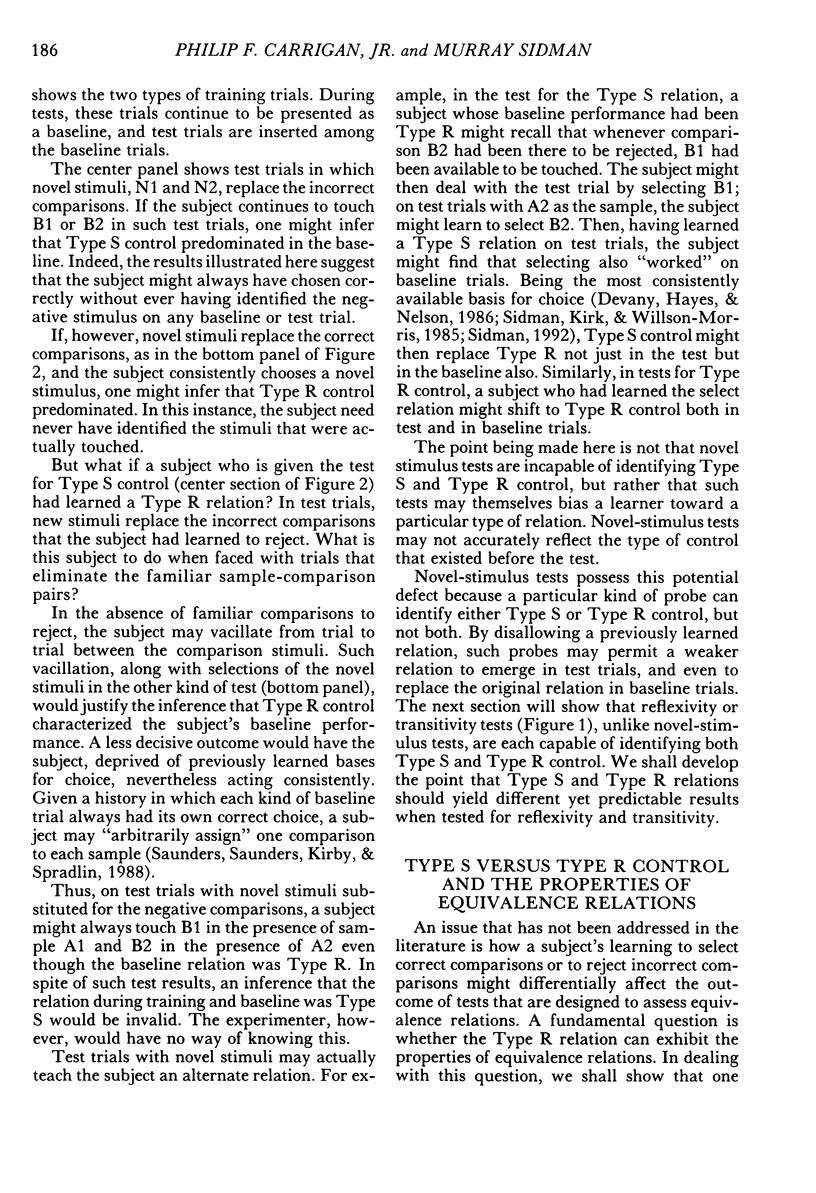


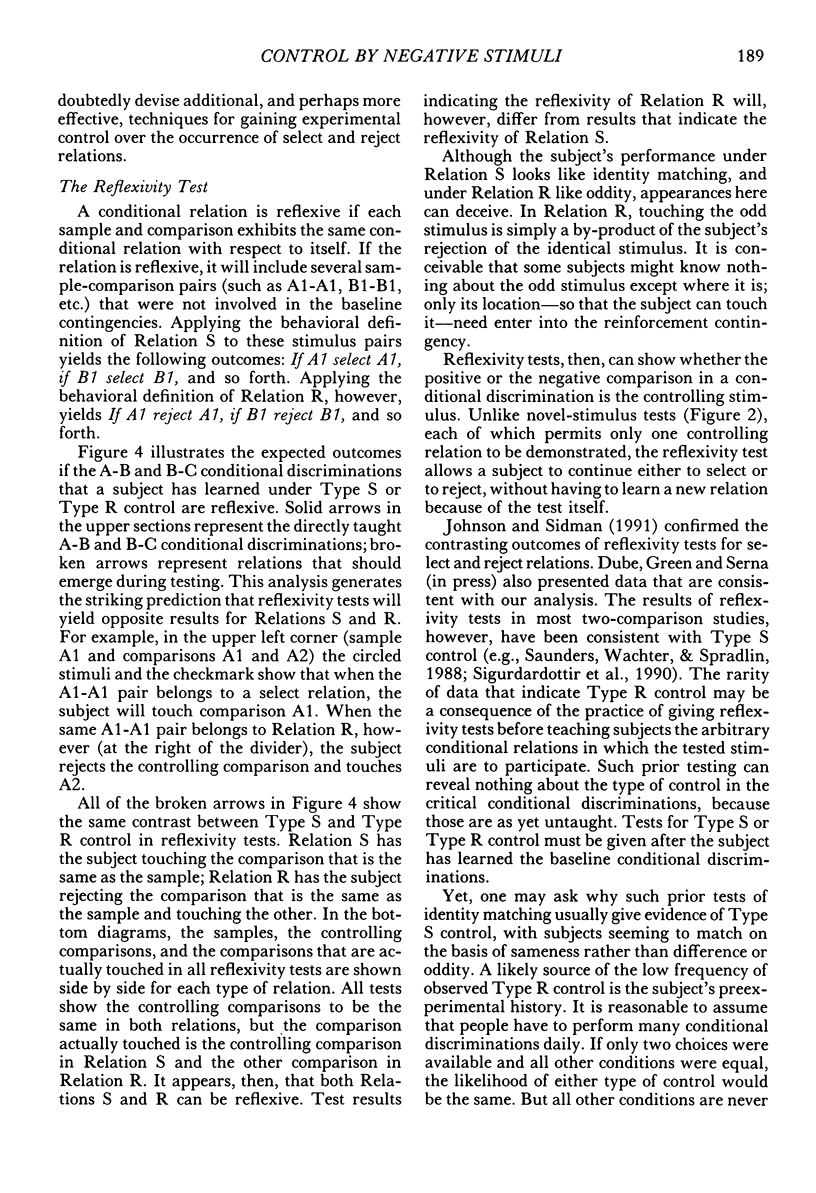

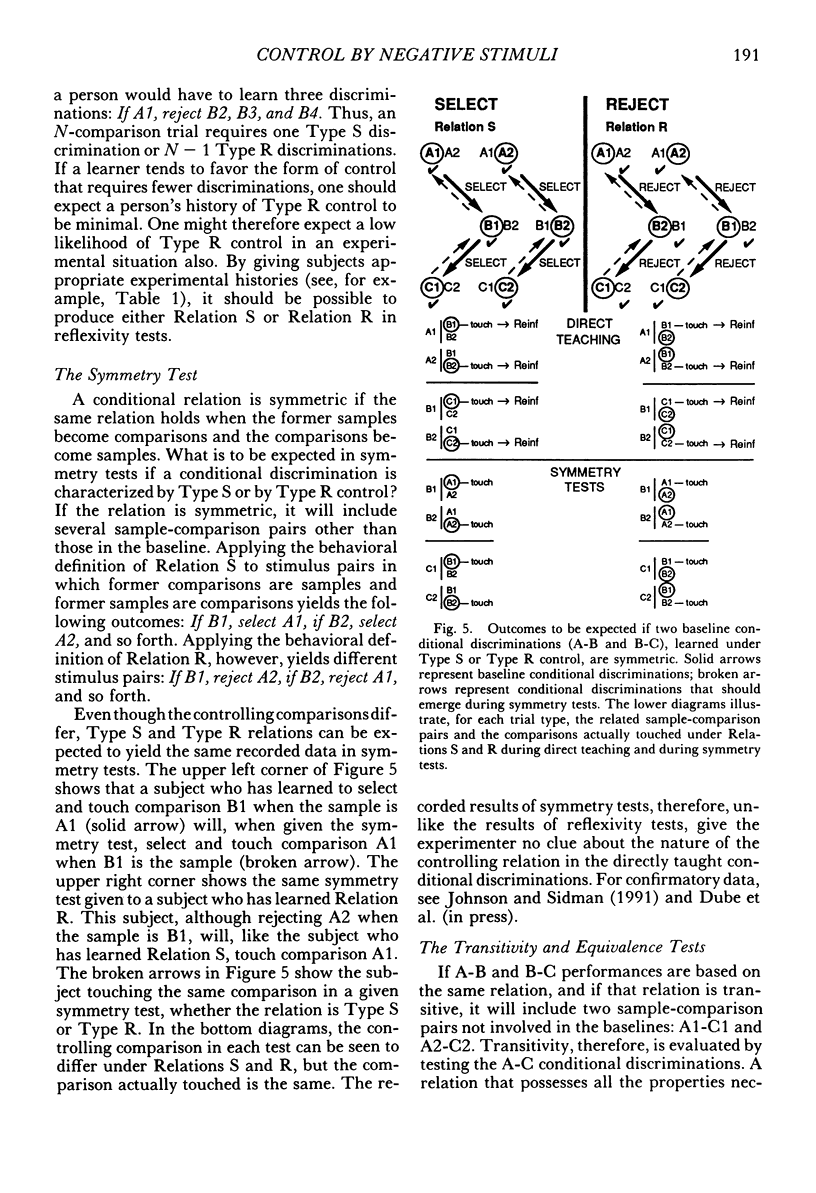
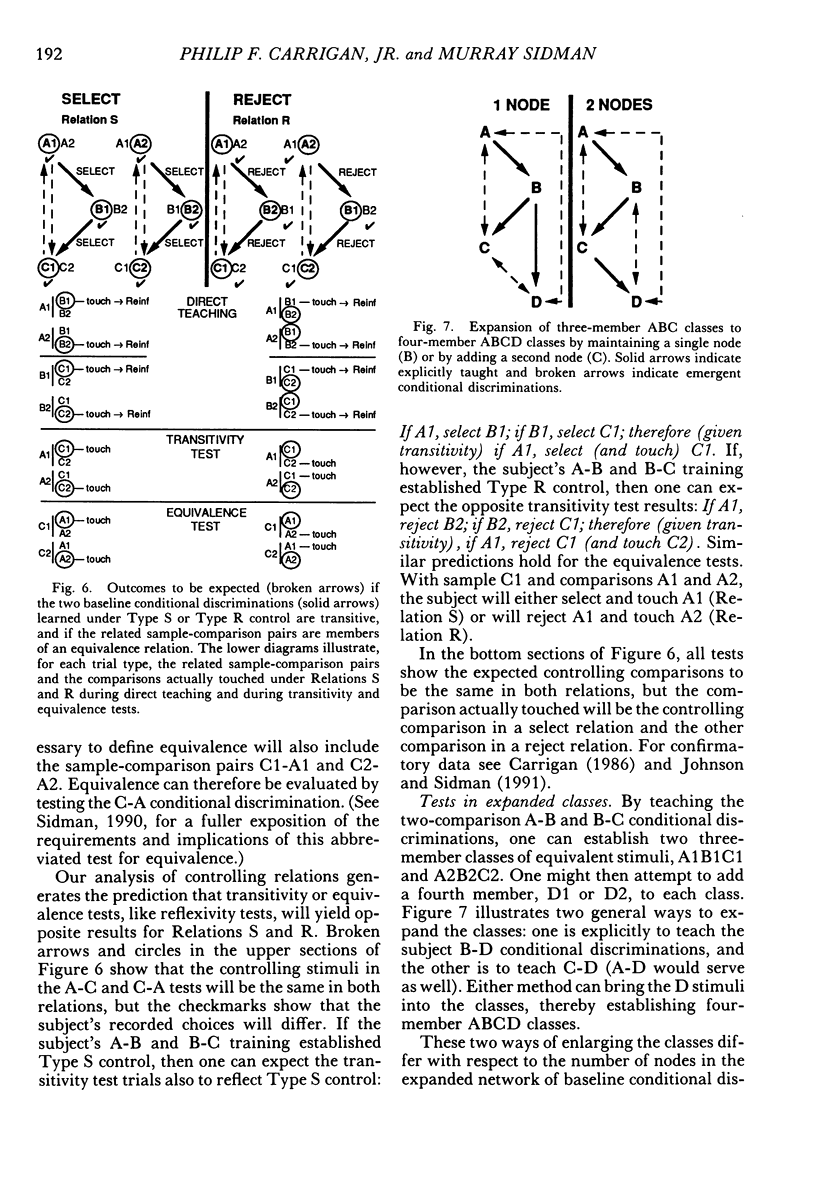





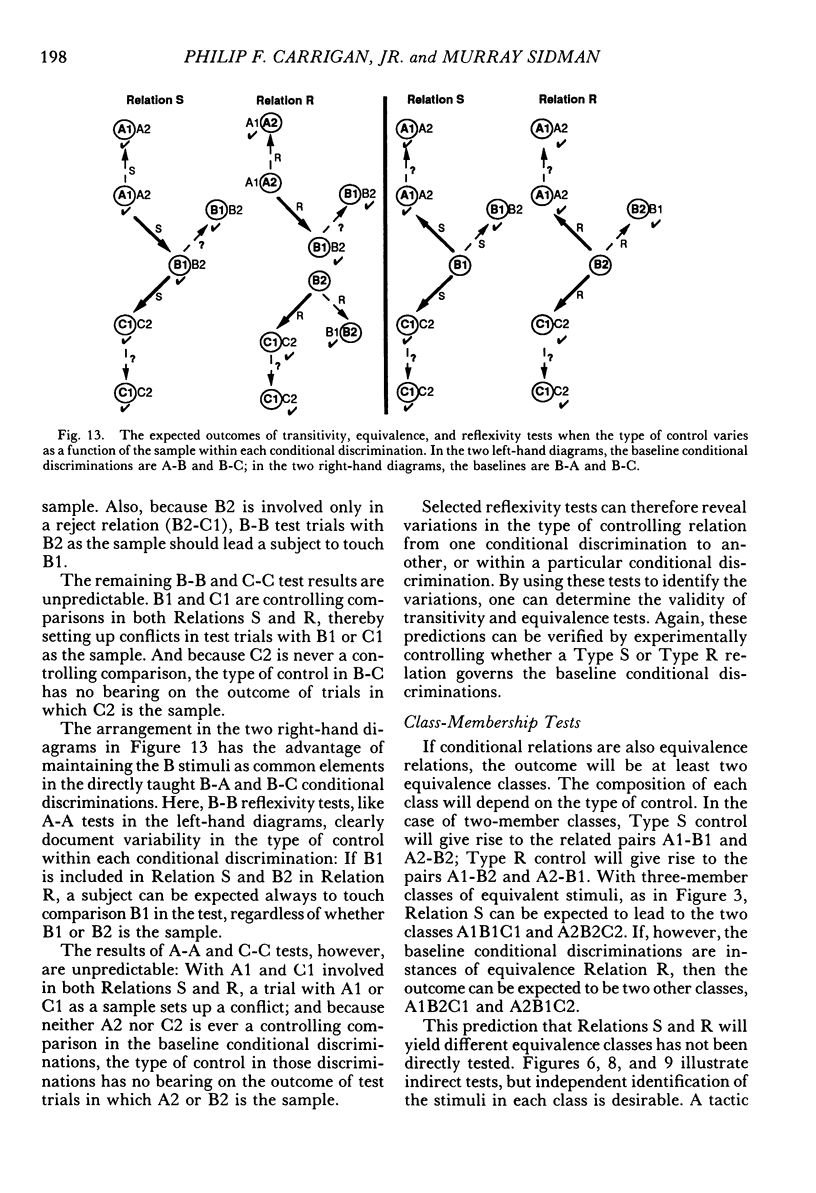
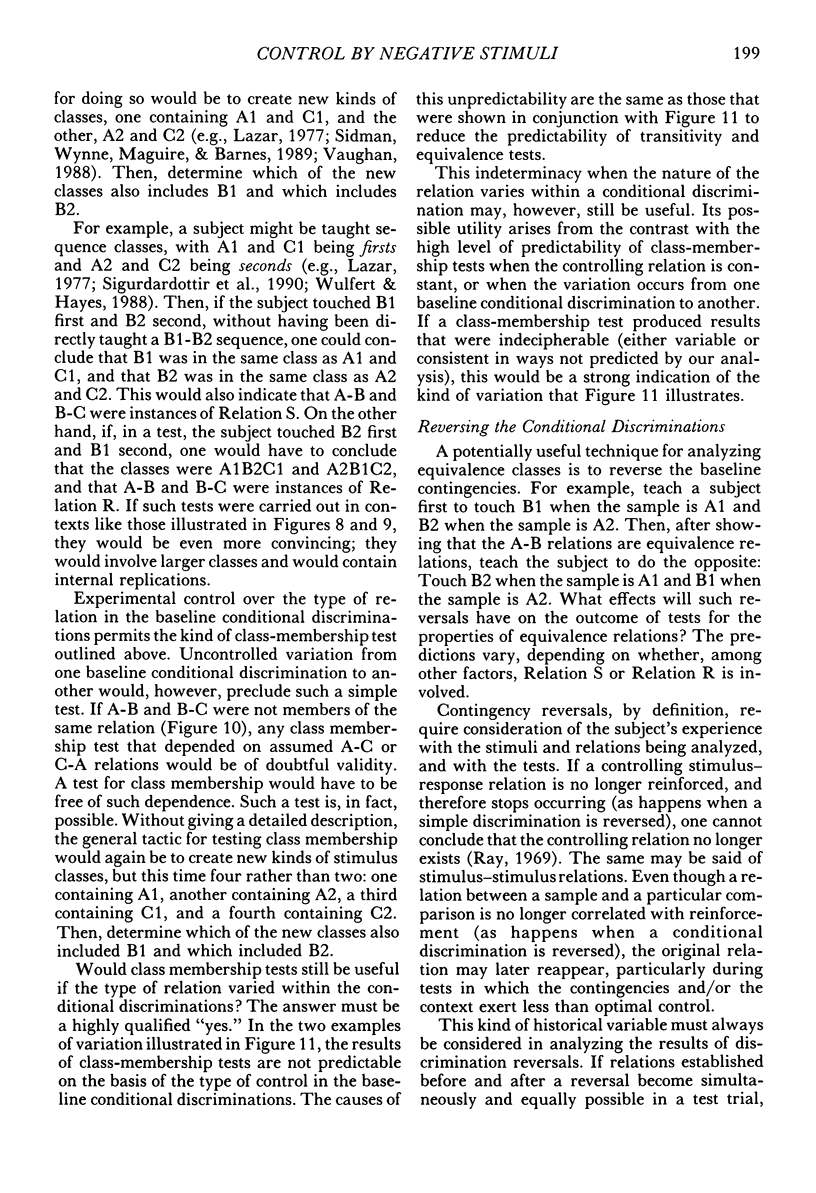

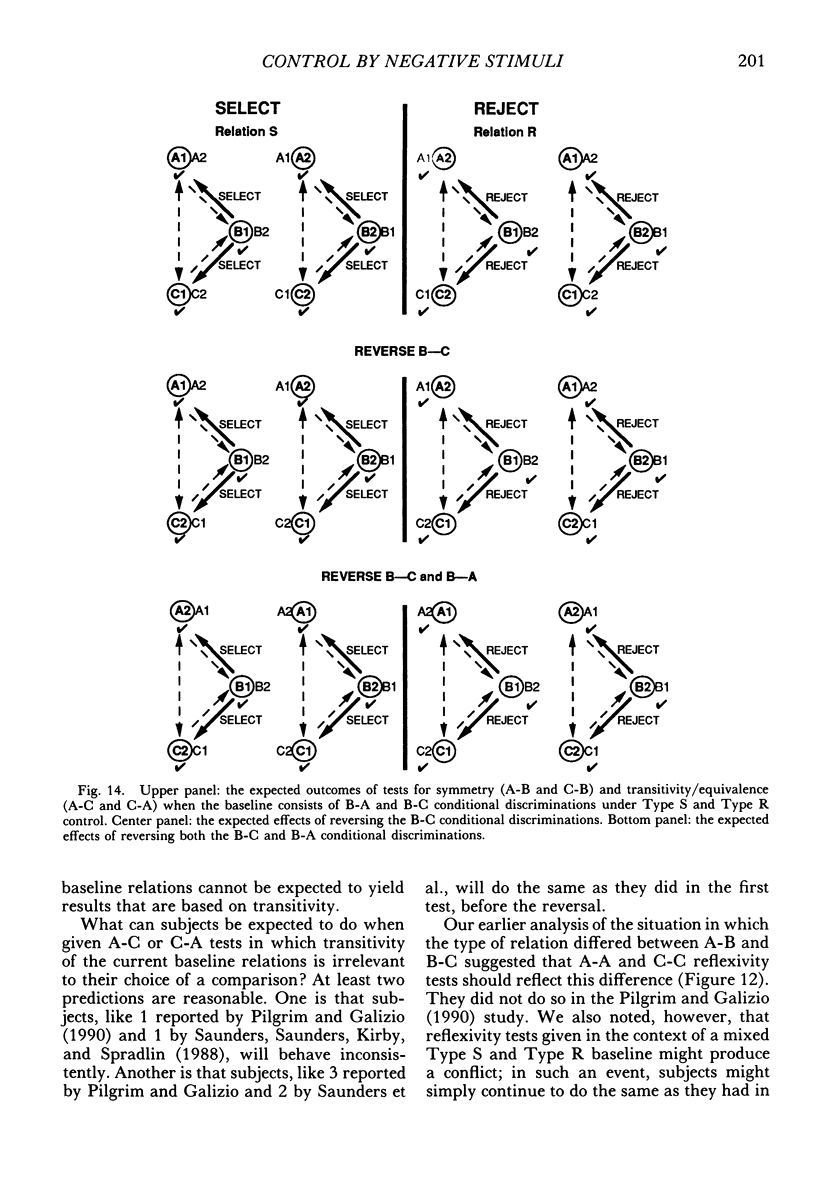

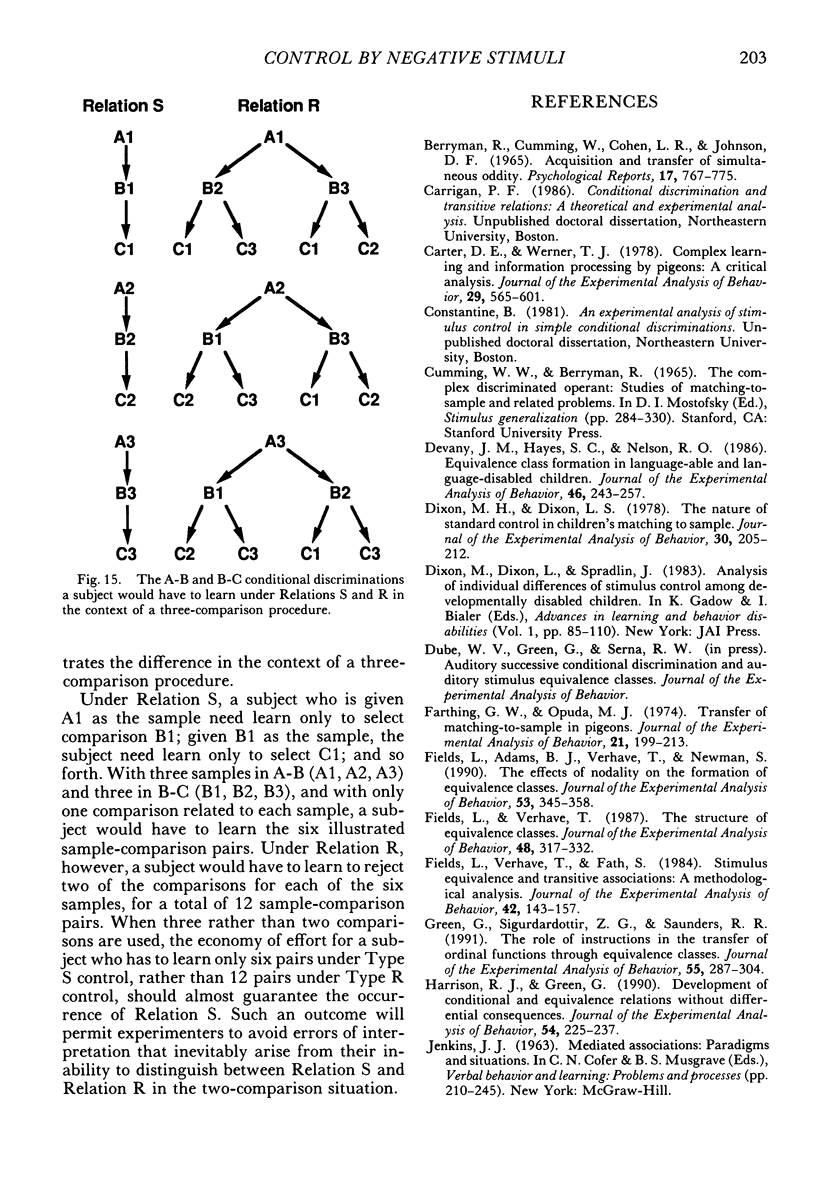

Selected References
These references are in PubMed. This may not be the complete list of references from this article.
- Berryman R., Cumming W. W., Cohen L. R., Johnson D. F. Acquisition and transfer of simultaneous oddity. Psychol Rep. 1965 Dec;17(3):767–775. doi: 10.2466/pr0.1965.17.3.767. [DOI] [PubMed] [Google Scholar]
- Carter D. E., Werner T. J. Complex learning and information processing by pigeons: a critical analysis. J Exp Anal Behav. 1978 May;29(3):565–601. doi: 10.1901/jeab.1978.29-565. [DOI] [PMC free article] [PubMed] [Google Scholar]
- Devany J. M., Hayes S. C., Nelson R. O. Equivalence class formation in language-able and language-disabled children. J Exp Anal Behav. 1986 Nov;46(3):243–257. doi: 10.1901/jeab.1986.46-243. [DOI] [PMC free article] [PubMed] [Google Scholar]
- Dixon M. H., Dixon L. S. The nature of standard control in children's matching-to-sample. J Exp Anal Behav. 1978 Sep;30(2):205–212. doi: 10.1901/jeab.1978.30-205. [DOI] [PMC free article] [PubMed] [Google Scholar]
- Farthing G. W., Opuda M. J. Transfer of matching-to-sample in pigeons. J Exp Anal Behav. 1974 Mar;21(2):199–213. doi: 10.1901/jeab.1974.21-199. [DOI] [PMC free article] [PubMed] [Google Scholar]
- Fields L., Adams B. J., Verhave T., Newman S. The effects of nodality on the formation of equivalence classes. J Exp Anal Behav. 1990 May;53(3):345–358. doi: 10.1901/jeab.1990.53-345. [DOI] [PMC free article] [PubMed] [Google Scholar]
- Fields L., Verhave T., Fath S. Stimulus equivalence and transitive associations: A methodological analysis. J Exp Anal Behav. 1984 Jul;42(1):143–157. doi: 10.1901/jeab.1984.42-143. [DOI] [PMC free article] [PubMed] [Google Scholar]
- Fields L., Verhave T. The structure of equivalence classes. J Exp Anal Behav. 1987 Sep;48(2):317–332. doi: 10.1901/jeab.1987.48-317. [DOI] [PMC free article] [PubMed] [Google Scholar]
- Green G., Sigurdardottir Z. G., Saunders R. R. The role of instructions in the transfer of ordinal functions through equivalence classes. J Exp Anal Behav. 1991 May;55(3):287–304. doi: 10.1901/jeab.1991.55-287. [DOI] [PMC free article] [PubMed] [Google Scholar]
- Harrison R. J., Green G. Development of conditional and equivalence relations without differential consequences. J Exp Anal Behav. 1990 Nov;54(3):225–237. doi: 10.1901/jeab.1990.54-225. [DOI] [PMC free article] [PubMed] [Google Scholar]
- Lazar R. M., Davis-Lang D., Sanchez L. The formation of visual stimulus equivalences in children. J Exp Anal Behav. 1984 May;41(3):251–266. doi: 10.1901/jeab.1984.41-251. [DOI] [PMC free article] [PubMed] [Google Scholar]
- Lazar R. Extending sequence-class membership with matching to sample. J Exp Anal Behav. 1977 Mar;27(2):381–392. doi: 10.1901/jeab.1977.27-381. [DOI] [PMC free article] [PubMed] [Google Scholar]
- McIlvane W. J., Kledaras J. B., Munson L. C., King K. A., de Rose J. C., Stoddard L. T. Controlling relations in conditional discrimination and matching by exclusion. J Exp Anal Behav. 1987 Sep;48(2):187–208. doi: 10.1901/jeab.1987.48-187. [DOI] [PMC free article] [PubMed] [Google Scholar]
- Pilgrim C., Galizio M. Relations between baseline contingencies and equivalence probe performances. J Exp Anal Behav. 1990 Nov;54(3):213–224. doi: 10.1901/jeab.1990.54-213. [DOI] [PMC free article] [PubMed] [Google Scholar]
- Ray B. A. Selective attention: the effects of combining stimuli which control incompatible behavior. J Exp Anal Behav. 1969 Jul;12(4):539–550. doi: 10.1901/jeab.1969.12-539. [DOI] [PMC free article] [PubMed] [Google Scholar]
- Saunders R. R., Green G. The nonequivalence of behavioral and mathematical equivalence. J Exp Anal Behav. 1992 Mar;57(2):227–241. doi: 10.1901/jeab.1992.57-227. [DOI] [PMC free article] [PubMed] [Google Scholar]
- Saunders R. R., Saunders K. J., Kirby K. C., Spradlin J. E. The merger and development of equivalence classes by unreinforced conditional selection of comparison stimuli. J Exp Anal Behav. 1988 Sep;50(2):145–162. doi: 10.1901/jeab.1988.50-145. [DOI] [PMC free article] [PubMed] [Google Scholar]
- Saunders R. R., Wachter J., Spradlin J. E. Establishing auditory stimulus control over an eight-member equivalence class via conditional discrimination procedures. J Exp Anal Behav. 1988 Jan;49(1):95–115. doi: 10.1901/jeab.1988.49-95. [DOI] [PMC free article] [PubMed] [Google Scholar]
- Sidman M., Kirk B., Willson-Morris M. Six-member stimulus classes generated by conditional-discrimination procedures. J Exp Anal Behav. 1985 Jan;43(1):21–42. doi: 10.1901/jeab.1985.43-21. [DOI] [PMC free article] [PubMed] [Google Scholar]
- Sidman M., Rauzin R., Lazar R., Cunningham S., Tailby W., Carrigan P. A search for symmetry in the conditional discriminations of rhesus monkeys, baboons, and children. J Exp Anal Behav. 1982 Jan;37(1):23–44. doi: 10.1901/jeab.1982.37-23. [DOI] [PMC free article] [PubMed] [Google Scholar]
- Sidman M., Tailby W. Conditional discrimination vs. matching to sample: an expansion of the testing paradigm. J Exp Anal Behav. 1982 Jan;37(1):5–22. doi: 10.1901/jeab.1982.37-5. [DOI] [PMC free article] [PubMed] [Google Scholar]
- Sidman M., Wynne C. K., Maguire R. W., Barnes T. Functional classes and equivalence relations. J Exp Anal Behav. 1989 Nov;52(3):261–274. doi: 10.1901/jeab.1989.52-261. [DOI] [PMC free article] [PubMed] [Google Scholar]
- Sigurdardottir Z. G., Green G., Saunders R. R. Equivalence classes generated by sequence training. J Exp Anal Behav. 1990 Jan;53(1):47–63. doi: 10.1901/jeab.1990.53-47. [DOI] [PMC free article] [PubMed] [Google Scholar]
- Steele D., Hayes S. C. Stimulus equivalence and arbitrarily applicable relational responding. J Exp Anal Behav. 1991 Nov;56(3):519–555. doi: 10.1901/jeab.1991.56-519. [DOI] [PMC free article] [PubMed] [Google Scholar]
- Stromer R., Osborne J. G. Control of adolescents' arbitrary matching-to-sample by positive and negative stimulus relations. J Exp Anal Behav. 1982 May;37(3):329–348. doi: 10.1901/jeab.1982.37-329. [DOI] [PMC free article] [PubMed] [Google Scholar]
- Urcuioli P. J., Nevin J. A. Transfer of hue matching in pigeons. J Exp Anal Behav. 1975 Sep;24(2):149–155. doi: 10.1901/jeab.1975.24-149. [DOI] [PMC free article] [PubMed] [Google Scholar]
- Wulfert E., Hayes S. C. Transfer of a conditional ordering response through conditional equivalence classes. J Exp Anal Behav. 1988 Sep;50(2):125–144. doi: 10.1901/jeab.1988.50-125. [DOI] [PMC free article] [PubMed] [Google Scholar]


